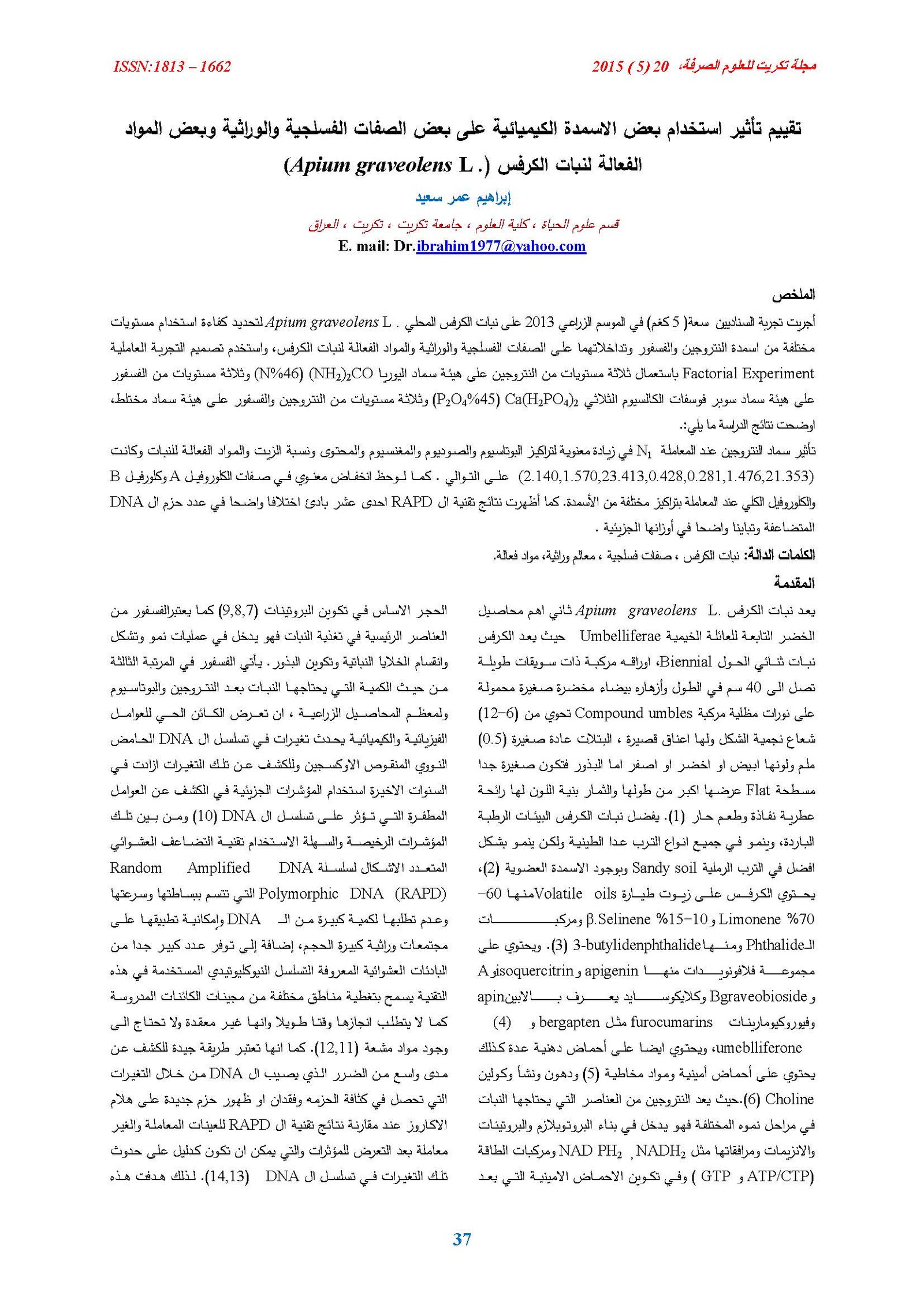The impact of the use of some chemical fertilizers on some physiological and genetic traits and some active substances to assess the celery plant (Apium graveolens L.)
Main Article Content
Abstract
Experiment conducted Alsnaddein capacity (5 kg) in the agricultural season in 2013 on the local plant celery Apium graveolens L. To determine the efficiency of the use of different levels of fertilizer nitrogen, phosphorus and their interaction on the physiological and genetic traits active substances to plant celery, and use the design of global experience Factorial Experiment using three levels of nitrogen in the form of urea (NH2) CO (N% 46 and three levels of phosphorus in the form of fertilizer Super triple calcium phosphate Ca (H2PO4) 2 (P2O4% 45) and three levels of nitrogen and phosphorus in the form of mixed fertilizer, said results of the study as follows :
effect of nitrogen fertilizer when the transaction N1 significant increase in potassium, sodium, magnesium, oil content and the percentage of active substances of plant concentrations were (2.140,1.570, 23. 413, 0.428, 0.281, 1.476,21.353) respectively. Significant decrease was also noted in recipes chlorophyll a and chlorophyll b and the total chlorophyll concentrations at the treatment of different fertilizers. The RAPD technique results also showed eleven initially clear difference in the number of DNA packs multiplying and clear contrast in molecular weights.
Article Details

This work is licensed under a Creative Commons Attribution 4.0 International License.
Tikrit Journal of Pure Science is licensed under the Creative Commons Attribution 4.0 International License, which allows users to copy, create extracts, abstracts, and new works from the article, alter and revise the article, and make commercial use of the article (including reuse and/or resale of the article by commercial entities), provided the user gives appropriate credit (with a link to the formal publication through the relevant DOI), provides a link to the license, indicates if changes were made, and the licensor is not represented as endorsing the use made of the work. The authors hold the copyright for their published work on the Tikrit J. Pure Sci. website, while Tikrit J. Pure Sci. is responsible for appreciate citation of their work, which is released under CC-BY-4.0, enabling the unrestricted use, distribution, and reproduction of an article in any medium, provided that the original work is properly cited.
References
1- March, M. D. (1998). PDR for herbal medicines. 1st (end) medical economics co. Moatvale. New Jersey. Pp: 341-373. Teny, C. M. (1988). Inhibition of platelet aggregation by apigenin from apium graveolens, Asia pacific J. pharmacol. , 1: 85 – 89.
2- Chakravarty, H. L. (1976). Plant Wealth of Iraq. Vol. 1. Ministry of Agriculture and Agrarian Reform, Baghdad, Iraq.
3- Bjeldanes, L. F. and I. S. Kim, (1977). Pathalide components of celery essential oil. J. Org. chem.., 42: 2333 – 2335.
4- Newell, C. A. (1996). Herbal medicine, a guide for health care professional. The pharmaceutical press, London, pp: 65 – 66.
9- Mengel, K., and E.A. Kirkby. 1982. Principles op plant nutrition 3rd ed. International. Potash. Institute. Bern. Switzerland.
10- Narayanan Mathiyazhagan and Devarajan Natarajan. Optimization of RAPD-PCR Protocol to Screen Jatropha Curcas and Gossypium Hirsutum Grown in Metal Contaminated Soil. J Pet Environ Biotechnol 2012, 3:1.
13- Aly, A. A., Application of DNA (RAPD) and ultrastructure to detect the effect of cadmium stress in Egyptian clover and Sudan grass plantlets. Journal of Stress Physiology & Biochemistry, Vol. 8 No. 1 2012, pp. 241-257.
14- Ilhan dogani, kekec, ibrahim ilker ozyigit and mehmet serdal sakcali . salinity induced changes in cotton (Gossypium Hirsutum L.). Pak. J. Bot., 44: 21-25, Special Issue March 2012.
15- Page, A.L., R.H. Miller and D.R. Keeny. 1982. Methods of soil analysis part 2,2nd(ed). Agron Pub.9, Madison, Wisconsin, USA. P.403-429.
17- Black, C.A. (1985) . Methods of soil Analysis. Part 2.
18- A.O.A.C.(1980) . Official Method of analysis of Association of Agriculture Chemist Washington, D.C, PP 1015.
19- Matt , J.(1970) . Calorimetric Determination of phosphorus in Soil and plant Material with Ascorbic acid . Soil . Sci. 109 : 219-220 .
20- Richards, L .A . (1954). Diagnosis and Improvement of Saline and Alkaline Soils . A.S.D.A Handbook, No. 6, USA.
21- Permingeat, H.R., M.V. Romagnoli and R.H. Vallejos (1998). A Simple Method for Isolating High Yield and Quality DNA from Cotton (Gossypium hirsutum L.) Leaves. Plant Molecular Biology Reporter, 16 : 1-6.
22- Willams, J.G.K., A.R. Kublik, K.J. Livake, J.A. Rafalski and S.V. Tingey (1990). DNA polymorphisms amplified by arbitrary primers are useful as genetic markers. Nucleic Acids Res., 18 : 6531-6535.
23- Sambrok, J.A.D.W.R. (2001). Molecular Cloning: A Laboratory Manual. 3rd ed.
25- Nishizawa, H.; S. Okimura, and Y. Abe, (1991).Application liquid particle extraction to the purification of glycyrrhizin. Chemical pharm. Bull. 39. 969 -971.
26- Weerachai, P.; and B. Duang (1998). Simple isolation and purification of glycyrrhizic acid. J. Sci. Fac.,25:87-91.
27- Wiley-VCH, Weinheim. doi: 10.1002/ 14356007. a17-265.d:
28- Keshan, U. and Mukherji, S.(1992). Effect of cadmium toxicity on chloroph5yll content, Hill activity and chlorophyllase activity in Vigna radiata leaves. Indian Journal of Plant Physiology( 3):225-230.
30- Schippers, R.R.2000. African indigenous vegetable. Pp. 56-60. An Overview of the cultivated species. Chatthan, U.K., N.R/ACO.EU.
31- Laue, W.; Thiemann, M.; Scheibler, E. and Wiegand, k. w.(2006). Nitrates and nitrites in Ullmanns encyclopedia of industrial chemistry,
34- Keshan,U. and Mukherji,S.(1992).Effect of cadmium toxicity on chloroph5yll content,Hill activity and chlorophyllase activity in Vigna radiata leaves. Indian Journal of Plant Physiology( 3):225-230.
38 - Atienzar FA, Cheung VV, Jha AN, Depledge MH. Fitness parame- ters and dna effects are sensitive indicators of copper-induced tox- icity in Daphnia magna. Toxicol Sci 2001; 59: 241-50.
39- Becerril C, Ferrero M, Castaño A. Detection by RAPD of genetic alterations in vitro: amplification and conservation conditions of DNA extracts. Toxicol Mech Methods 2002; 12(2): 155-67.
40- De Wolfe H, Blust R, Backeljau T. The use of RAPD in ecotoxi- cology. Mutat Res 2004; 566(3): 249-62.
41- Nelson JR, Lawrence CW, Hinkle DC. Thymine-thymine dimer bypass by yeast DNA polymerase. Science 1996; 272: 1646-49.
